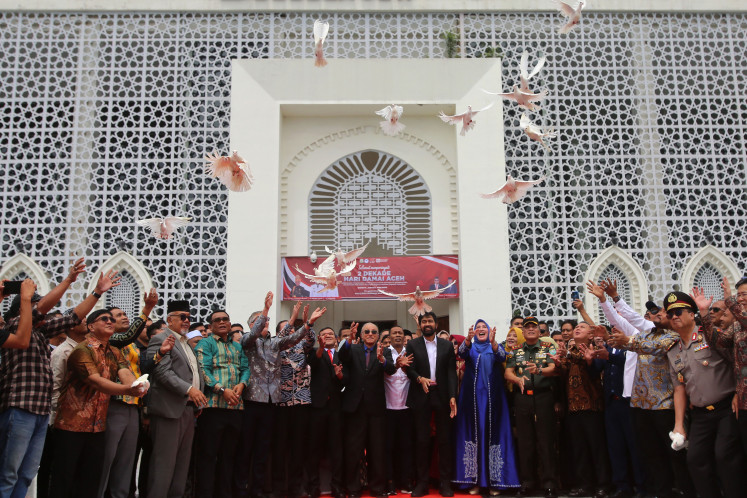Popular Reads
Top Results
Can't find what you're looking for?
View all search resultsPopular Reads
Top Results
Can't find what you're looking for?
View all search resultsChinese Temples and Its Stories
Asti Kleinsteuber: JP/Josh FaganThe book, Kelenteng-Kelenteng Kuno di Indonesia (The Old Chinese Temples in Indonesia), which discusses the history of Chinese temples and includes hundreds of color photographs, drew a significant crowd at its official launch last week
Change text size
Gift Premium Articles
to Anyone
Asti Kleinsteuber: JP/Josh Fagan
The book, Kelenteng-Kelenteng Kuno di Indonesia (The Old Chinese Temples in Indonesia), which discusses the history of Chinese temples and includes hundreds of color photographs, drew a significant crowd at its official launch last week.
It was a cause for celebration for author Asti Kleinsteuber as well as members of the Chinese business community, friends and supporters, who were glad to see the first book about Chinese temples in Indonesia.
There was a symbolic significance to the book launch, as it was one of the first Chinese cultural events to be hosted by the Ministry of Culture and Tourism.
Culture and Tourism Ministry’s marketing director general Sapta Nirwandar said in his opening speech that the book and its associated launch reflected the growing diplomatic and cultural links between Indonesia and China.
“From this book, we know better and understand better the history of Chinese culture,” Sapta said.
“Having the book launch here in the government building, we as the government are trying to accommodate the Chinese community and welcome the cultural celebration.”
Author Asti Kleinsteuber read parts of the book aloud and said the launch was an important occasion for many people.
“The point is not just about the book itself, but about the tradition, the ancient cultures that are reflected in the kelenteng [temple],” Asti said.
She said she was inspired to write the book after a lifelong interest in China and Chinese culture.
“When I was a child I liked to see all the red colors and the dragons, and I dreamt of going to China to see the Great Wall and the terracotta army.”
It took more than two years for Asti and her team of photographers and publishers to gather their collection of photographs and historical research.
The research involved not only visiting every kelenteng across Indonesia but looking into the history of temples that had not been previously written about.
“Sometimes the people from the kelenteng didn’t know their own kelenteng because it’s not written anywhere, there was no reference of it in any history,” Asti says.
“People of Chinese descent who’ve been here for five or six generations would like to know more about their own culture and history, so I think that made it even more important to complete the book,” she said.
While visiting the Chinese temples, Asti and photographer Syafri Munardi faced a couple of minor hindrances with security.
“Once or twice security didn’t want to let us in or for us to take photographs, but we never tried to force them,” she says. “We just said OK and went to another kelenteng.”
Chief photographer for the book, Syafri Munardi, said the publication was well worth the work that went into it.
“Even though I’m Muslim, this job was important for me because the temples are special sites,” Syafri said.
“It was something new for me to take photos of the Buddhist temples; we had to be careful visiting the sacred places where they pray.
“This is the first book about Kelenteng in Indonesia so it is important for that as well,” he said.
The history of Chinese temples goes back a long way to the first Chinese settlers who landed in Indonesia on their way to India around the year 700 AD.
Asti‘s husband, Fritz Kleinsteuber, was among the team that helped research the history of the book.
“It’s a fascinating history. You look back into the origins of the temples and they date back hundreds of years,” Kleinsteuber said.
“In 1405, there was a strong immigration of Chinese into Indonesia, and those who were sick were left in Java — they were left to die.
“But they survived and many of them built new lives, and they built Chinese temples, which is why you see a lot of temples along the coastline,” he said.
Today there are more than 1,000 Chinese temples in Indonesia.
The temples have a unique history as one of the places of worship that welcome a plurality of religions.
Inside the temples, which are usually grand architectural designs, people practice “Chinese folk religion” -- a blend of China’s three main religions: Buddhism, Taoism and Confucianism.
The documentation of the temples’ history was a significant moment for many of the guests present at the book launch, who said they were happy to be there to see its publication.
It was also an occasion of renewed optimism for the future of Chinese and Indonesian relations.
Asti Kleinsteuber said she hopes the book will help promote interest in Indonesia’s Chinese culture.
“I think the government is already working with the Chinese community and trying to get tourists to come here, so I hope this book will help people see the cultural history.”
The first ever book written about Indonesia’s Chinese temples signals a growing interest in Chinese culture and increasingly harmonious relations with the Chinese community.
‘Kelenteng-Kelenteng Kuno di Indonesia’
(The Old Chinese Temples in Indonesia)
Publisher…, 2011
Page ..










